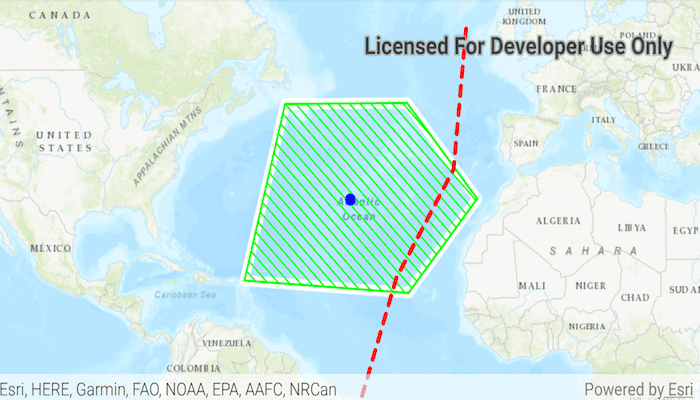Determine spatial relationships between two geometries.

Use case
In case of a natural disaster, emergency services can represent the affected areas using polygons. By determining the spatial relationships between these and any other existing features such as populated areas, infrastructure, or natural resources, it is possible to quickly determine which of the existing features might be affected or is in further danger, helping to assess risk and define further action.
How to use this sample
Select one of the three graphics. The relationships activity will show the spatial relationships the selected graphic has to the other graphic geometries.
How it works
- Get the geometry from two different graphics. In this example the geometry of the selected graphic is compared to the geometry of each unselected graphic.
- Use the methods in
GeometryEngineto check the relationship between the geometries, e.g.contains,disjoint,intersects, etc. If the method returnstrue, the relationship exists.
Relevant API
- Geometry
- GeometryEngine
- GeometryType
- Graphic
- Point
- Polygon
- Polyline
Tags
geometries, relationship, spatial analysis
Sample Code
/* Copyright 2018 Esri
*
* Licensed under the Apache License, Version 2.0 (the "License");
* you may not use this file except in compliance with the License.
* You may obtain a copy of the License at
*
* http://www.apache.org/licenses/LICENSE-2.0
*
* Unless required by applicable law or agreed to in writing, software
* distributed under the License is distributed on an "AS IS" BASIS,
* WITHOUT WARRANTIES OR CONDITIONS OF ANY KIND, either express or implied.
* See the License for the specific language governing permissions and
* limitations under the License.
*
*/
package com.esri.arcgisruntime.sample.spatialrelationships;
import java.util.ArrayList;
import java.util.HashMap;
import android.content.Context;
import android.view.LayoutInflater;
import android.view.View;
import android.view.ViewGroup;
import android.widget.BaseExpandableListAdapter;
import android.widget.TextView;
/**
* Expandable list view adapter groups the results from a HashMap.
*/
class ExpandableListAdapter extends BaseExpandableListAdapter {
private final Context context;
private final ArrayList<String> mGroupList;
private final HashMap<String, ArrayList<String>> mChildList;
public ExpandableListAdapter(Context context, ArrayList<String> header, HashMap<String, ArrayList<String>> child) {
this.context = context;
mGroupList = new ArrayList<>(header);
mChildList = child;
}
@Override public int getGroupCount() {
return mGroupList.size();
}
@Override public int getChildrenCount(int groupPosition) {
return mChildList.get(mGroupList.get(groupPosition)).size();
}
@Override public Object getGroup(int groupPosition) {
return mGroupList.get(groupPosition);
}
@Override public Object getChild(int groupPosition, int childPosition) {
return mChildList.get(mGroupList.get(groupPosition)).get(childPosition);
}
@Override public long getGroupId(int groupPosition) {
return groupPosition;
}
@Override public long getChildId(int groupPosition, int childPosition) {
return childPosition;
}
@Override public boolean hasStableIds() {
return false;
}
@Override public View getGroupView(int groupPosition, boolean isExpanded, View convertView, ViewGroup parent) {
String groupTitle = mGroupList.get(groupPosition);
if (convertView == null) {
LayoutInflater layoutInflater = (LayoutInflater) context.getSystemService(Context.LAYOUT_INFLATER_SERVICE);
convertView = layoutInflater.inflate(R.layout.header, null);
}
TextView listTitleTextView = convertView.findViewById(R.id.header);
listTitleTextView.setText(groupTitle);
return convertView;
}
@Override public View getChildView(int groupPosition, final int childPosition, boolean isLastChild, View convertView,
ViewGroup parent) {
String childText = (String) getChild(groupPosition, childPosition);
if (convertView == null) {
LayoutInflater layoutInflater = (LayoutInflater) context.getSystemService(Context.LAYOUT_INFLATER_SERVICE);
convertView = layoutInflater.inflate(R.layout.childs, null);
}
TextView childView = convertView.findViewById(R.id.child);
childView.setText(childText);
return convertView;
}
@Override public boolean isChildSelectable(int groupPosition, int childPosition) {
return true;
}
}